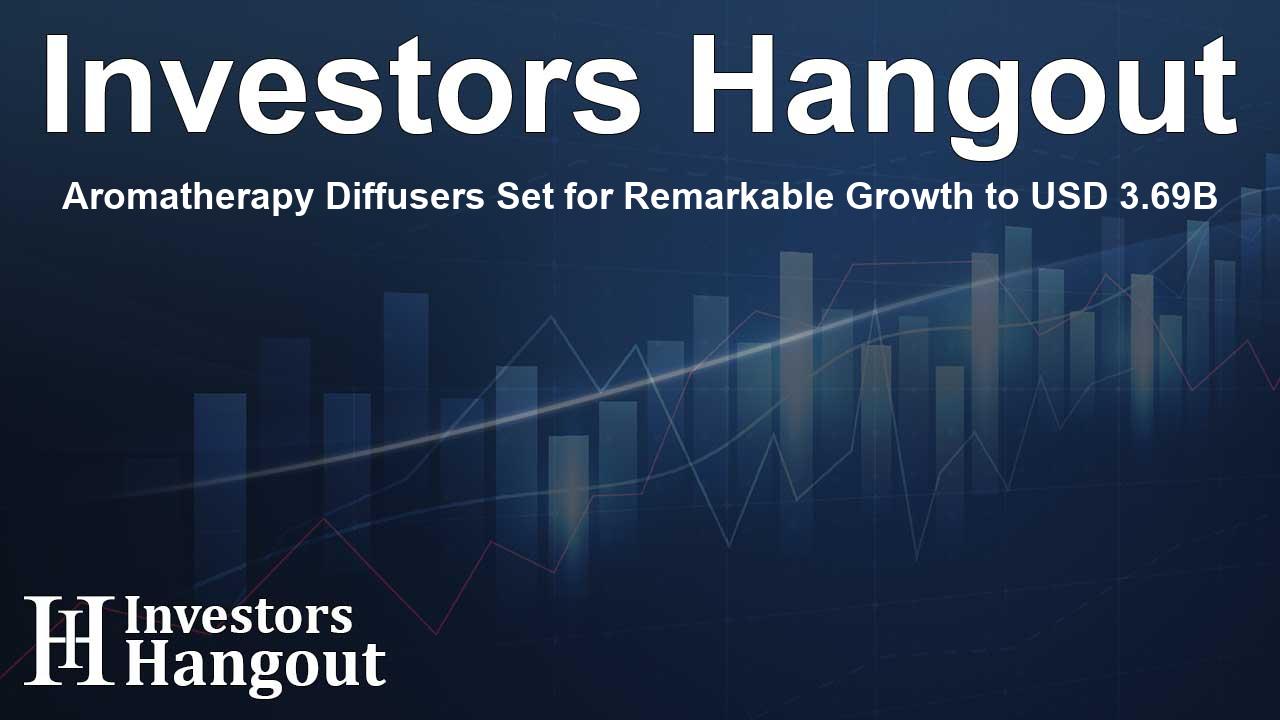Aromatherapy Diffusers Set for Remarkable Growth to USD 3.69B

Aromatherapy Diffusers Market Growth Outlook
The aromatherapy diffusers market is gaining traction as it evolves into a billion-dollar industry. Initially valued at USD 2.12 billion, experts forecast a remarkable upswing, projecting its worth to hit USD 3.69 billion over the coming years with a compound annual growth rate (CAGR) of 7.19%. This growth is championed by a notable shift in consumer behavior emphasizing holistic wellness solutions and sustainable practices.
Emerging Trends Shaping the Market
As individuals increasingly prioritize their mental and physical well-being, there is a noticeable surge in the adoption of home wellness solutions, particularly aromatherapy diffusers. Enhanced FDA guidelines have built consumer confidence regarding essential oil labeling, leading to greater trust in the products. Brands are responding to this demand with innovative and eco-friendly collections, notably Saje Natural Wellness. Additionally, influential companies such as Young Living and doTERRA are expanding their presence in retail, indicating a burgeoning market led by heightened consumer awareness.
The U.S. Market Dynamics
In the United States, the aromatherapy diffusers market is expected to grow from USD 0.67 billion and reach USD 1.14 billion by the end of the projected timeframe. The increasing focus on wellness and enhanced décor options from leading U.S. brands is fueling this growth. Organizations, including the American Aromatherapy Association, emphasize the rise in consumer interest, while new product ranges from Saje and Vitruvi showcase ongoing diversification in the industry.
Key Players in the Industry
The aromatherapy diffusers landscape features several key players who are heavily invested in capturing market share:
- Young Living Essential Oils
- NOW Foods
- doTERRA International
- SpaRoom
- Muji
- GreenAir, Inc.
- Vitruvi
- ESCENTS
- Organic Aromas
- Puzhen
Market Attributes and Insights
According to recent analysis, the aromatherapy diffusers market attributes are as follows:
- 2024 Market Size: USD 2.12 billion
- 2032 Forecast: USD 3.69 billion
- CAGR: 7.19% from 2025 to 2032
- Base Year: 2024
- Forecast Period: 2025-2032
Segmentation of the Aromatherapy Diffusers Market
The market is segmented into several categories impacting its growth:
Types of Diffusers
In 2024, ultrasonic diffusers dominated the market, capturing an impressive 66% share. This segment is favored for its silent operation and energy efficiency, allowing essential oils to disperse without heat. Brands such as InnoGear and Vitruvi have introduced models featuring energy-efficient technology, automatic shut-off options, and aesthetic lighting, making them increasingly popular among consumers.
Distribution Channels
Retailers also held the largest share of the market in 2024, accounting for 48%. This preference stems from consumers wanting to experience diffusers firsthand, allowing them to assess design and sound quality. The significant expansion of aromatherapy sections in stores like Bed Bath & Beyond and Target supports this growth trend.
Applications of Diffusers
The spa and relaxation segment holds the largest market share at 52%. Aromatherapy diffusers have become a staple in spa settings, creating serene atmospheres essential for relaxation. With over 70% of U.S. spas investing in advanced diffuser systems, this application’s significance in the market is assured.
Regional Breakdown of Market Trends
North America remains the frontrunner within the aromatherapy diffusers market, holding a 44% share in 2024. The region benefits from high disposable incomes and a robust cultural inclination towards holistic health practices. Prominent retailers are keenly focused on expanding their product lines, pairing stylish diffusers with essential oils to meet evolving consumer preferences.
Conclusion
The growth trajectory for the aromatherapy diffusers market is anchored in changing consumer habits favoring wellness and sustainability. With the right innovation and strategic positioning, companies within this space are poised for substantial growth in the upcoming years, reflecting a notable shift towards holistic well-being.
Frequently Asked Questions
What is the projected value of the aromatherapy diffusers market by 2032?
The aromatherapy diffusers market is expected to reach USD 3.69 billion by 2032.
Which segment dominates the aromatherapy diffusers market?
The ultrasonic segment dominated the market in 2024, capturing a majority market share of 66%.
What drives the growth of the U.S. aromatherapy diffusers market?
Growth in the U.S. market is driven by rising wellness awareness and innovative domestic brands offering new product lines.
Who are the key players in the aromatherapy diffusers industry?
Notable players include Young Living Essential Oils, doTERRA International, and Vitruvi among others.
How does the distribution channel affect the aromatherapy diffusers market?
Retailers dominate the distribution channel, as consumers prefer to experience products in person before making purchases.
About The Author
Contact Hannah Lewis privately here. Or send an email with ATTN: Hannah Lewis as the subject to contact@investorshangout.com.
About Investors Hangout
Investors Hangout is a leading online stock forum for financial discussion and learning, offering a wide range of free tools and resources. It draws in traders of all levels, who exchange market knowledge, investigate trading tactics, and keep an eye on industry developments in real time. Featuring financial articles, stock message boards, quotes, charts, company profiles, and live news updates. Through cooperative learning and a wealth of informational resources, it helps users from novices creating their first portfolios to experts honing their techniques. Join Investors Hangout today: https://investorshangout.com/
The content of this article is based on factual, publicly available information and does not represent legal, financial, or investment advice. Investors Hangout does not offer financial advice, and the author is not a licensed financial advisor. Consult a qualified advisor before making any financial or investment decisions based on this article. This article should not be considered advice to purchase, sell, or hold any securities or other investments. If any of the material provided here is inaccurate, please contact us for corrections.
